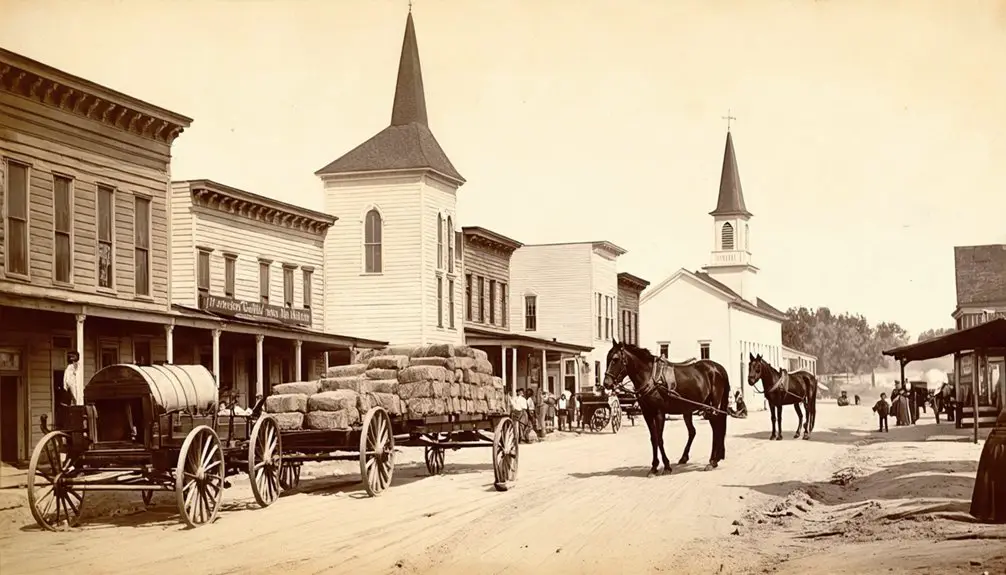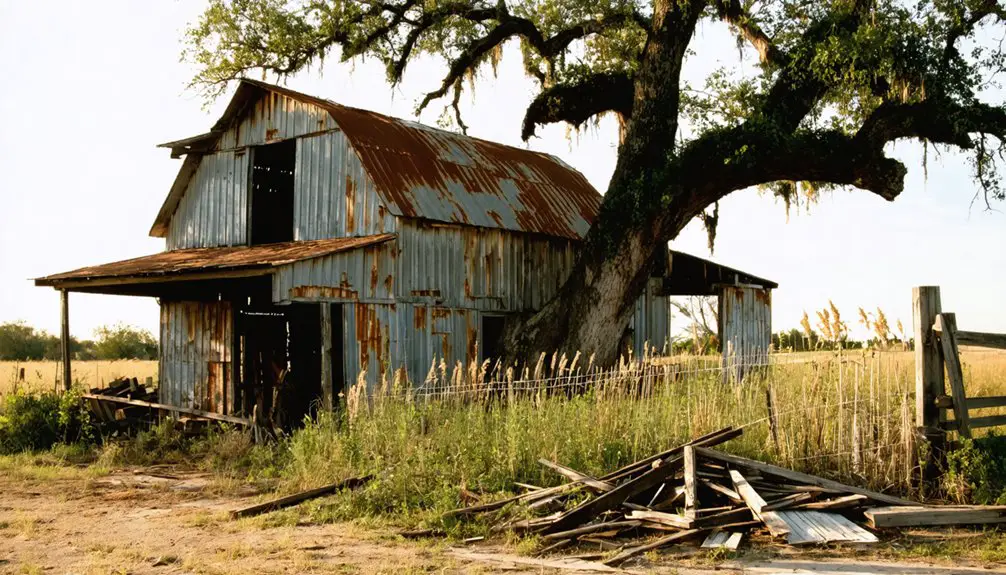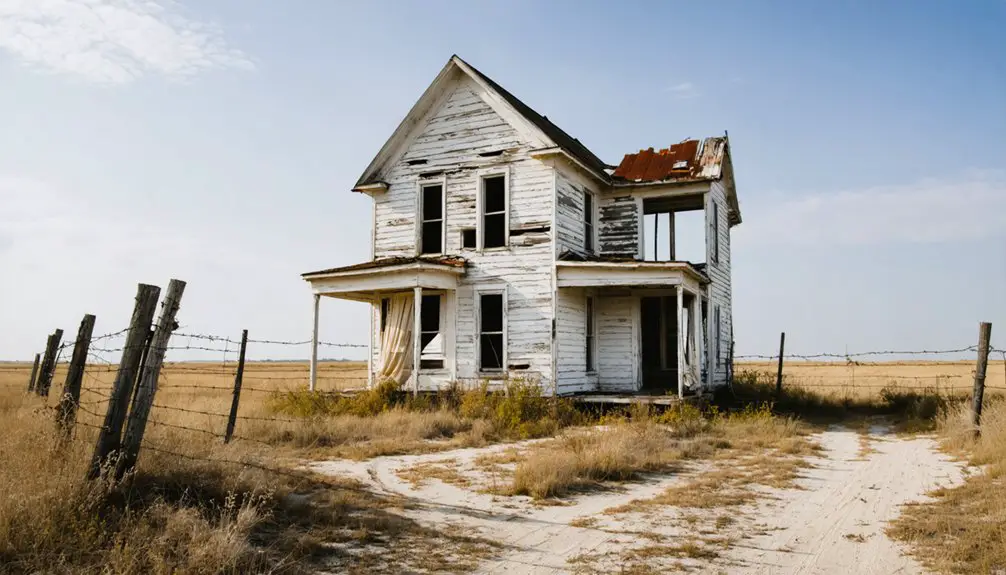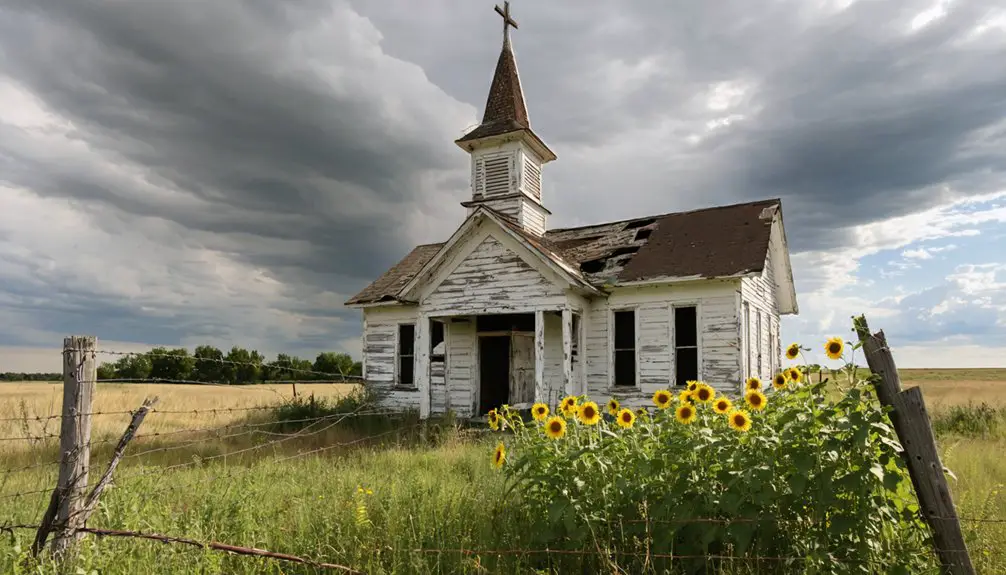You’ll find Auburn nine miles west of Kress, Texas, where a once-bustling agricultural settlement thrived in the late 1800s. This frontier community peaked at 250 residents in the 1880s, anchored by four churches, a post office, and a red brick schoolhouse. When railroads bypassed the town, Auburn’s prominence faded rapidly. By 2000, only 40 residents remained, making it one of Texas’s countless ghost towns with a compelling story of boom and decline.
Key Takeaways
- Auburn, Texas peaked at 250 residents in the 1880s but declined to just 40 residents by 2000, becoming a ghost town.
- The town’s decline began when railroad routes bypassed Auburn, severing crucial trade connections and economic opportunities.
- Located nine miles west of Kress, Auburn was established before 1900 as an agricultural community with essential services.
- Key structures included a red brick schoolhouse, grocery store, blacksmith shop, and post office serving from 1877 to 1906.
- Today, minimal physical evidence remains of Auburn’s structures, though preservation groups work to document its history.
The Birth of a Texas Settlement
While the exact founding date remains unclear, Auburn emerged as a Texas settlement before 1900, establishing itself as a small but essential agricultural community in the late 19th century.
Auburn stands as a testament to Texas’s rural heritage, taking root as a vital farming community in the 1800s.
Similar to Auburn, Oregon’s gold mining era, Auburn, Texas saw an initial period of rapid development as newcomers arrived seeking opportunities.
You’ll find the settlement dynamics typical of frontier Texas, with farmers and merchants creating a self-sustaining town centered around essential services. The town was strategically located nine miles west of Kress.
The community foundations were laid with the establishment of key institutions, including a local school organized in 1893, a grocery store, and a blacksmith shop.
Auburn’s development mirrored the pattern of rural Texas settlements, where scattered homesteads gradually coalesced into small towns.
Nearby, you’ll discover the settlement of Center Plains emerged during the same period, creating a network of rural communities that would later combine resources to sustain their shared future.
Life in Early Auburn
Life in early Auburn revolved around a close-knit community of settlers who arrived in the 1850s, establishing a self-reliant frontier society.
You’d find the post office serving as the heart of town life from 1877 to 1906, where locals gathered to exchange news and collect mail. Community gatherings centered around churches, where religious activities provided both spiritual guidance and social connection. The area developed similarly to other historic districts named Auburn across America during this period.
Daily life meant working the land, but some residents supplemented their income through trades like brick masonry or seasonal work in nearby mining towns like Thurber. The miners who came to work faced low monthly wages and were often paid in company scrip.
Though isolated, the town’s residents maintained strong bonds through shared experiences and mutual support.
You’d see modest homes and practical buildings dotting the landscape, while the Auburn Cemetery stood as a memorial to the area’s heritage.
Agricultural Roots and Trade
In Auburn’s early days, you’d find cotton dominating the agricultural landscape, with local farmers utilizing traditional picking and ginning methods to process their harvests.
The town’s strategic position allowed farmers to establish trading connections with nearby markets, helping them distribute cotton, corn, and livestock products efficiently through both overland routes and eventual rail links. Like many rural Texas communities facing population decline, Auburn struggled to maintain its economic vitality as younger generations moved away. The parallels to rural depopulation described in Goldsmith’s 1770 poem reflect similar patterns of migration from farming communities.
Your ancestors’ farming operations benefited from Auburn’s development of local marketplaces where agricultural goods could be traded, though this prosperity remained heavily dependent on maintaining viable transportation routes to larger commercial centers.
Early Cotton Production Methods
Three distinct phases marked early cotton production in Auburn and the surrounding Texas region. You’d have found the first phase beginning with Spanish missionaries introducing cotton cultivation in the 1740s, followed by Anglo-American settlers expanding production after 1821.
The second phase saw intensive manual labor systems, with slaves working the fields until the Civil War, later replaced by sharecroppers and tenant farmers. Under this system, tenant farmers received about two-thirds of their cotton’s value while sharecroppers got half. By the late 1800s, the region contributed to Texas reaching 3.5 million bales of cotton annually.
The third phase saw the transformation brought by the cotton gin and early mechanization efforts.
Throughout these periods, you’d have seen families working together through the seasonal cycle – planting, hoeing, and hand-picking cotton.
They’d save their best seeds for the next season, gradually adapting their crops to local conditions while experimenting with crop rotation to maintain soil health.
Local Market Development Impact
Auburn’s early market development centered around essential agricultural trade hubs that shaped the community’s economic foundation. The local economy thrived on critical market infrastructure including a grocery store and blacksmith shop, which served the surrounding farms’ daily needs. Like many ghost towns in Gregg County, the presence of steam grist mills helped process local grain harvests.
The red brick schoolhouse doubled as a community center, facilitating informal trade gatherings, while the Center Plains Gin provided crucial cotton processing capabilities for area farmers. Similar to Ross Sterling’s success, most of Auburn’s wealth concentrated among a few prominent business owners rather than benefiting the broader farming community.
However, you’ll find that Auburn’s market potential was severely limited by its lack of railroad access, a fate similar to nearby Gomez. Without direct rail connections for shipping cotton and corn to broader markets, the town’s economic integration suffered.
This transportation deficit, combined with regional agricultural shifts, ultimately contributed to Auburn’s decline, with its population dwindling to just 40 residents by 2000.
Farming Community Trading Routes
While early settlers established their roots in Auburn’s fertile soil, they quickly developed an intricate network of trading routes that connected local farmers to essential markets throughout the region.
These pathways served as lifelines for your agricultural ancestors, allowing them to transport cotton, corn, and other crops to neighboring communities.
When the railroads arrived in nearby towns, you’d have witnessed a revolution in farming innovations.
The Missouri, Kansas and Texas Railroad, along with the International and Great Northern Railroad, transformed Auburn’s trade networks.
Farmers switched from slow-moving oxen teams to efficient rail transport, dramatically reducing shipping times and costs.
You’d have seen local stores and blacksmith shops emerge along these routes, creating critical hubs where farmers could exchange goods, access equipment, and process cotton at nearby gins.
The Town’s Peak Years

During Auburn’s peak years between 1880-1940, you’d have found a bustling rural community of up to 150 residents engaged in farming, commerce, and seasonal labor.
You could’ve witnessed the daily rhythms of trade at general stores and saloons, which served both townspeople and surrounding agricultural families.
The town’s economic importance showed in its essential infrastructure, including a post office, churches, and schools, all supporting the local population’s needs.
Population and Daily Life
Four church organizations anchored life in Auburn during its 1880s peak, when approximately 250 residents called this rural Texas community home.
Churches weren’t just places of worship – they served as essential social institutions where community gatherings strengthened bonds between farming families.
Daily life in Auburn centered around:
- Subsistence farming with crops and livestock
- Church socials and market day events
- Basic education at the local schoolhouse
- Trading with local craftsmen and merchants
You’d find most families living in modest wood-frame or log homes they’d built themselves, relying on wells for water and wood stoves for heat.
While the population wasn’t large compared to railroad towns, Auburn’s tight-knit community sustained itself through shared labor, church membership, and regular social interactions until younger residents began seeking opportunities elsewhere.
Trade and Local Commerce
As Auburn reached its commercial zenith in the 1880s, you’d find a bustling marketplace where mercantile stores, hotels, and specialized shops served both local residents and travelers along established trade routes.
Local merchants’ roles extended beyond simple shopkeeping, as they transformed their establishments into crucial community hubs where you could purchase everything from farming supplies to daily provisions.
The town’s trade dynamics revolved around its strategic location near springs and rivers, facilitating robust commerce with nearby ranching communities.
You’d witness seasonal livestock auctions, trade fairs, and a constant flow of agricultural goods through the town’s stagecoach stops and later rail connections.
Banking services emerged to support this commercial activity, while specialized businesses like blacksmith shops, wagon factories, and lumberyards kept Auburn’s economic engine running.
Factors Behind the Decline
The combination of changing transportation routes and economic shifts dealt devastating blows to Auburn’s survival as a viable Texas settlement.
Shifting transportation patterns and economic decline converged to doom Auburn’s future, transforming a once-promising Texas town into a memory.
Like many small Texas towns of its era, Auburn faced multiple challenges that ultimately led to its abandonment.
You’ll find the key factors that sealed Auburn’s fate were:
- Railroad rerouting that bypassed the settlement, cutting off crucial trade connections and access to regional markets
- Loss of essential transportation infrastructure, including the closure of local depots and shipping points
- Inability to diversify beyond its primary economic activities when market conditions changed
- Declining population as residents relocated to find work, leading to the closure of critical community services
These circumstances created a domino effect, where each setback amplified the impact of others, ultimately transforming Auburn into another Texas ghost town.
What Remains Today

Modern visitors to Auburn’s former site will find little evidence of the once-thriving Texas settlement.
Like many ghost town remnants across the state, Auburn’s structures have largely deteriorated or disappeared entirely, with only scattered foundations marking where buildings once stood.
You’ll discover that nature has reclaimed much of the area, as decades of weathering and neglect have reduced most structures to rubble.
While the site’s historical significance endures, there’s minimal physical evidence of Auburn’s past glory.
A handful of private landowners now control the former townsite, making preservation efforts challenging.
Local historical societies occasionally conduct tours and maintain records of Auburn’s story, but you won’t find any preserved buildings or dedicated museum facilities at the location itself.
Auburn’s Historical Legacy
Founded in the 1850s during Ellis County’s early settlement period, Auburn established itself as a quintessential rural Texas community that exemplified the state’s westward expansion.
The town’s cultural heritage and community resilience live on through:
Heritage endures through the spirit of community, preserving stories and traditions that shaped who we are today.
- Historical records documenting daily life in a typical 19th-century farming settlement
- Stories of agricultural fairs and church gatherings that shaped local identity
- Remnants of original structures that once housed schools and general stores
- Documentation of how railroad decisions impacted small town survival
While you won’t find Auburn thriving today, its legacy offers valuable insights into Texas’ rural development.
The town’s story reflects the broader narrative of countless settlements that emerged during America’s expansion era, preserving a snapshot of pioneer life and the economic forces that shaped Texas’ landscape.
Preserving the Memory

While Auburn’s historical legacy endures through documentation and stories, active preservation efforts now shape how future generations will remember this Ellis County settlement.
You’ll find that preservation challenges in Auburn mirror those of many Texas ghost towns, where limited local populations and aging structures make sustained conservation difficult.
Community engagement has become vital to keeping Auburn’s memory alive. Local preservation groups work to document the town’s remaining features and share its story through educational outreach programs.
They’re partnering with regional organizations to secure funding for fundamental structural stabilization projects. Through these collaborative efforts, you’re seeing Auburn’s history being protected despite the obstacles of modern development and weather-related deterioration.
These initiatives guarantee that Auburn’s role in Texas frontier history won’t be forgotten.
Frequently Asked Questions
Were There Any Notable Crimes or Lawlessness in Auburn’s History?
Like dark shadows in history, you’ll find Auburn’s lawlessness history includes a slave’s violent murder of Penn Younge on a twisting staircase, plus wartime violence when the chapel served as a makeshift hospital.
What Happened to the Cemetery and Burial Grounds of Auburn’s Residents?
You’ll find Auburn’s cemetery largely abandoned, with minimal burial preservation efforts. Many graves deteriorated from weathering and neglect after the town’s decline, while others fell victim to vandalism and natural erosion.
Did Any Famous Texas Personalities Ever Visit or Stay in Auburn?
You won’t find records of any famous visitors or historical figures staying in Auburn. The town’s short-lived existence and lack of rail access kept it off prominent Texans’ travel routes.
Were Native American Settlements Present in the Auburn Area Before Establishment?
Yes, you’ll find extensive evidence of Native American settlement patterns in the Auburn area, where Caddo peoples established villages and ceremonial centers along Auburn Creek for thousands of years before European colonization.
Did Auburn Have Its Own Newspaper or Post Office During Operation?
Just like many small frontier outposts, you won’t find any records of Auburn having its own newspaper or post office. You’d have relied on nearby towns for your mail and news needs.
References
- https://mix941kmxj.com/the-strange-sad-story-of-a-texas-ghost-town-youll-never-visit/
- https://www.onlyinyourstate.com/experiences/california/ghost-towns-in-northern-california
- https://texashighways.com/travel-news/four-texas-ghost-towns/
- https://www.youtube.com/watch?v=phjUE19A8HM
- https://www.geotab.com/ghost-towns/
- https://kids.kiddle.co/List_of_ghost_towns_in_Texas
- https://en.wikipedia.org/wiki/List_of_ghost_towns_in_Texas
- https://www.tshaonline.org/handbook/entries/auburn-tx
- https://sites.rootsweb.com/~txecm/communit.htm
- https://www.texasalmanac.com/places/auburn-1



